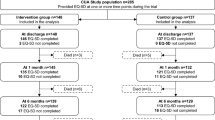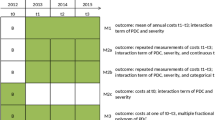Abstract
Background
Prescription drug costs have been rising rapidly in the USA, contributing to the persistent problem of cost-related medication nonadherence (CRN) among older Medicare beneficiaries. Given the importance of CRN and the negative outcomes associated with it, it is important to examine the factors that affect CRN. This study aims to estimate the factors influencing CRN among older Medicare beneficiaries and to rank their relative contribution in explaining CRN.
Methods
We used a 2015 Medicare Current Beneficiary Survey linked to Medicare claims data to identify older Medicare beneficiaries aged 65 years and over. Multivariate logistic regression was performed to identify factors associated with CRN. Factors included in the regression analyses were based on a conceptual framework adapted from Piette et al., including main effects (financial factors and regimen complexity) and contextual factors (sociodemographic, lifestyle and health factors). Dominance analysis was conducted to determine their relative importance in predicting CRN.
Results
Our study sample included 4427 older Medicare beneficiaries, 13.43% of whom reported CRN. For main effects, drug coverage and regimen complexity were significantly associated with CRN. Compared to beneficiaries with public coverage, those with private drug coverage were less likely to report CRN while those without drug coverage were more likely to report CRN. Having more than two monthly prescriptions was also associated with higher CRN. Significant contextual factors included age, activities of daily living limitations, perceived health status, cancer, rheumatoid arthritis, non-rheumatoid arthritis, depression, and lung disease. Dominance analysis showed drug coverage was the most influential factor in explaining CRN, after which age, ADL limitations, and depression ranked in sequence.
Conclusions
These findings can help policy makers understand the relative importance of factors affecting CRN and identify the most important areas for intervention to improve CRN.

Similar content being viewed by others
Data Availability
The data source used for this study is the Medicare Current Beneficiary Survey (MCBS) linked with Medicare claims. It is available upon request from the MCBS program.
References
He W, Goodkind D, Kowal PR. An aging world: 2015. Washington, DC: United States Census Bureau; 2016.
Nobili A, Garattini S, Mannucci PM. Multiple diseases and polypharmacy in the elderly: challenges for the internist of the third millennium. J Comorbidities. 2011;1:28–44.
Schumock GT, Stubbings J, Wiest MD, Li EC, Suda KJ, Matusiak LM, et al. National trends in prescription drug expenditures and projections for 2018. Am J Health Syst Pharm. 2018;75:1023–38.
Kesselheim AS, Avorn J, Sarpatwari A. The high cost of prescription drugs in the United States: origins and prospects for reform. JAMA. 2016;316:858–71.
Madden JM, Graves AJ, Zhang F, Adams AS, Briesacher BA, Ross-Degnan D, et al. Cost-related medication nonadherence and spending on basic needs following implementation of Medicare Part D. JAMA. 2008;299:1922–8.
Piette JD, Heisler M, Wagner TH. Cost-related medication underuse among chronically III adults: the treatments people forgo, how often, and who is at risk. Am J Public Health. 2004;94:1782–7.
Tamblyn R, Laprise R, Hanley JA, Abrahamowicz M, Scott S, Mayo N, et al. Adverse events associated with prescription drug cost-sharing among poor and elderly persons. JAMA. 2001;285:421–9.
Heisler M, Langa KM, Eby EL, Fendrick AM, Kabeto MU, Piette JD. The health effects of restricting prescription medication use because of cost. Med Care. 2004;42:626–34.
Zivin K, Ratliff S, Heisler MM, Langa KM, Piette JD. Factors influencing cost-related nonadherence to medication in older adults: a conceptually based approach. Value Health. 2010;13:338–45.
Piette JD, Heisler M, Horne R, Alexander GC. A conceptually based approach to understanding chronically ill patients’ responses to medication cost pressures. Soc Sci Med. 2006;62:846–57.
Briesacher BA, Gurwitz JH, Soumerai SB. Patients at-risk for cost-related medication nonadherence: a review of the literature. J Gen Intern Med. 2007;22:864–71.
Zhang JX, Lee JU, Meltzer DO. Risk factors for cost-related medication non-adherence among older patients with diabetes. World J Diabetes. 2014;5:945–50.
Zhang JX, Meltzer DO. Risk factors for cost-related medication non-adherence among older patients with cancer. Integr Cancer Sci Ther. 2015;2:300–4.
Blumberg DM, Prager AJ, Liebmann JM, Cioffi GA, De Moraes CG. Cost-related medication nonadherence and cost-saving behaviors among patients with glaucoma before and after the implementation of Medicare Part D. JAMA Ophthalmol. 2015;133:985–96.
Harrold LR, Briesacher BA, Peterson D, Beard A, Madden J, Zhang F, et al. Cost-related medication nonadherence in older patients with rheumatoid arthritis. J Rheumatol. 2013;40:137–43.
Kang H, Lobo JM, Kim S, Sohn M-W. Cost-related medication non-adherence among US adults with diabetes. Diabetes Res Clin Pract. 2018;143:24–33.
Gonzalez JS, Peyrot M, McCarl LA, Collins EM, Serpa L, Mimiaga MJ, et al. Depression and diabetes treatment nonadherence: a meta-analysis. Diabetes Care. 2008;31:2398–403.
Centers for Medicare and Medicaid Service. Medicare Current Beneficiary Survey related files. https://www.cms.gov/MCBS. Accessed Dec 2018.
Burcu M, Alexander GC, Ng X, Harrington D. Construct validity and factor structure of survey-based assessment of cost-related medication burden. Med Care. 2015;53:199–206.
Piette JD, Beard A, Rosland AM, McHorney CA. Beliefs that influence cost-related medication non-adherence among the “haves” and “have nots” with chronic diseases. Patient Pref Adherence. 2011;5:389–96.
Centers for Disease Control and Prevention. About adult BMI. http://www.cdc.gov/healthyweight/assessing/bmi/adult_bmi/index.html. Accessed Dec 2018.
Bambauer KZ, Safran DG, Ross-Degnan D, Zhang F, Adams AS, Gurwitz J, et al. Depression and cost-related medication nonadherence in Medicare beneficiaries. Arch Gen Psychiatry. 2007;64:602–8.
Zivin K, Madden JM, Zhang F, Soumerai SB, Graves AJ. Cost-related medication nonadherence among beneficiaries with depression following Medicare Part D. Am J Geriatr Psychiatry. 2009;17:1068–76.
Rogers WH, Wilson IB, Bungay KM, Cynn DJ, Adler DA. Assessing the performance of a new depression screener for primary care (PC-SAD). J Clin Epidemiol. 2002;55:164–75.
Rogers WH, Adler DA, Bungay KM, Wilson IB. Depression screening instruments made good severity measures in a cross-sectional analysis. J Clin Epidemiol. 2005;58:370–7.
Azen R, Budescu DV. The dominance analysis approach for comparing predictors in multiple regression. Psychol Methods. 2003;8:129–48.
Azen R, Traxel N. Using dominance analysis to determine predictor importance in logistic regression. J Educ Behav Stat. 2009;34:319–47.
Grömping U. Estimators of relative importance in linear regression based on variance decomposition. Am Statistician. 2007;261:139–47.
Luchman JN. Determining subgroup difference importance with complex survey designs: an application of weighted dominance analysis. Surv Pract. 2015;8:1–10.
Soumerai SB, Pierre-Jacques M, Zhang F, Ross-Degnan D, Adams AS, Gurwitz J, et al. Cost-related medication nonadherence among elderly and disabled medicare beneficiaries: a national survey 1 year before the medicare drug benefit. Arch Intern Med. 2006;166:1829–35.
Kaiser Family Foundation. How does prescription drug spending and use compare across large employer plans, Medicare Part D, and Medicaid? https://www.kff.org/medicare/issue-brief/how-does-prescription-drug-spending-and-use-compare-across-large-employer-plans-medicare-part-d-and medicaid/. Accessed May 2019.
Gellad WF, Grenard J, McGlynn EA, Gellad WF, Grenard JL, McGlynn EA. A review of barriers to medication adherence. In: A framework for driving policy options. Santa Monica, CA: RAND Corp; 2009.
Aziz H, Hatah E, Bakry MM, et al. How payment scheme affects patients’ adherence to medications? A systematic review. Patient Prefer Adherence. 2016;10:837–50.
Cohen MJ, Shaykevich S, Cawthon C, Kripalani S, Paasche-Orlow MK, Schnipper JL. Predictors of medication adherence postdischarge: the impact of patient age, insurance status, and prior adherence. J Hosp Med. 2012;7:470–5.
Gazmararian J, Jacobson KL, Pan Y, Schmotzer B, Kripalani S. Effect of a pharmacy-based health literacy intervention and patient characteristics on medication refill adherence in an urban health system. Ann Pharmacother. 2010;44:80–7.
Hinkin CH, Hardy DJ, Mason KI, Castellon SA, Durvasula RS, Lam MN, et al. Medication adherence in HIV-infected adults: effect of patient age, cognitive status, and substance abuse. AIDS. 2004;18(Suppl. 1):S19–25.
Zhang JX, Lee JU, Pandey K, Meltzer DO. Variation in cost-related medication non-adherence with functional limitations and frequency of hospitalization in older adults. Ann Gerontol Geriatric Res. 2015;2(1):1023.
Chan L, Beaver S, MacLehose RF, Jha A, Maciejewski M, Doctor JN. Disability and health care costs in the Medicare population. Arch Phys Med Rehab. 2002;83:1196–201.
MacLachlan M, Mannan H, McAuliffe E. Access to health care of persons with disabilities as an indicator of equity in health systems. Open Med. 2011;5:e10.
Pellegrino LD, Peters ME, Lyketsos CG, Marano CM. Depression in cognitive impairment. Curr Psychiatry Rep. 2013;15:384.
Campbell NL, Boustani MA, Skopelja EN, Gao S, Unverzagt FW, Murray MD. Medication adherence in older adults with cognitive impairment: a systematic evidence-based review. Am J Geriatr Pharmacother. 2012;10:165–77.
Nekhlyudov L, Madden J, Graves AJ, Zhang F, Soumerai SB, Ross-Degnan D. Cost-related medication nonadherence and cost-saving strategies used by elderly Medicare cancer survivors. J Cancer Surviv. 2011;5:395–404.
Tran G, Zafar SY. Financial toxicity and implications for cancer care in the era of molecular and immune therapies. Ann Transl Med. 2018;6(9):166.
Peppercorn J. Financial toxicity and societal costs of cancer care: distinct problems require distinct solutions. Oncologist. 2017;22(2):123–5.
Aikens JE, Piette JD. Diabetic patients’ medication underuse, illness outcomes, and beliefs about antihyperglycemic and antihypertensive treatments. Diabetes Care. 2009;32:19–24.
Piette JD, Heisler M, Wagner TH. Medication characteristics beyond cost alone influence decisions to underuse pharmacotherapy in response to financial pressures. J Clin Epidemiol. 2006;59:739–46.
Yap AF, Thirumoorthy T, Kwan YH. Medication adherence in the elderly. J Clin Gerontol Geriatr. 2016;7:64–7.
Chang-Quan H, Bi-Rong D, Zhen-Chan L, Yuan Z, Yu-Sheng P, Qing-Xiu L. Collaborative care interventions for depression in the elderly: a systematic review of randomized controlled trials. J Investig Med. 2009;57:446–55.
Acknowledgements
We thank Gary Deyter for his editorial assistance.
Author information
Authors and Affiliations
Contributions
All authors contributed to the planning, conduct, and reporting of the work described in the article. Dian Gu is responsible for the overall content as the guarantor.
Corresponding author
Ethics declarations
Funding
No funding was received for the conduct of this study or the preparation of this article.
Conflict of interest
Dian Gu and Chan Shen have no conflicts of interest that are directly relevant to the content of this article.
Ethics Approval
This study received institutional review board exemption status from the University of Texas MD Anderson Cancer Center.
Rights and permissions
About this article
Cite this article
Gu, D., Shen, C. Assessing the Importance of Factors Associated with Cost-Related Nonadherence to Medication for Older US Medicare Beneficiaries. Drugs Aging 36, 1111–1121 (2019). https://doi.org/10.1007/s40266-019-00715-3
Published:
Issue Date:
DOI: https://doi.org/10.1007/s40266-019-00715-3




